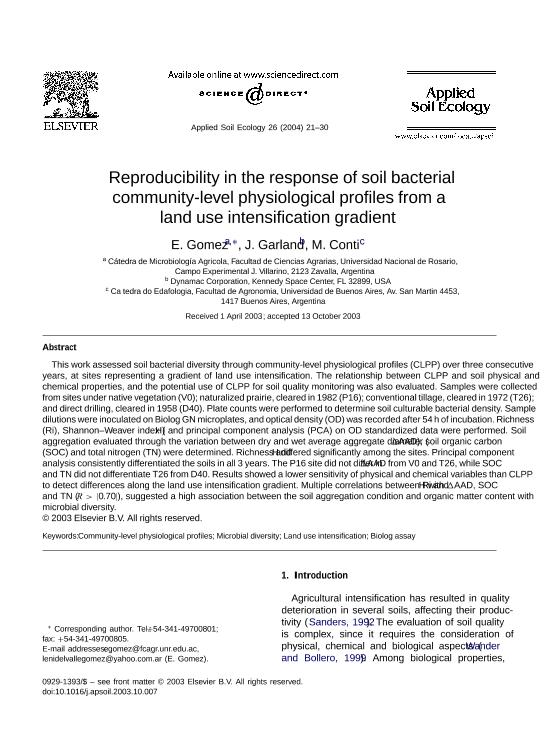Mostrar el registro sencillo del ítem
dc.contributor.author
Gomez, E.
dc.contributor.author
Garland, J.
dc.contributor.author
Conti, Marta Elvira

dc.date.available
2022-07-12T15:18:41Z
dc.date.issued
2004-05
dc.identifier.citation
Gomez, E.; Garland, J.; Conti, Marta Elvira; Reproducibility in the response of soil bacterial community-level physiological profiles from a land use intensification gradient; Elsevier Science; Applied Soil Ecology; 26; 1; 5-2004; 21-30
dc.identifier.issn
0929-1393
dc.identifier.uri
http://hdl.handle.net/11336/161901
dc.description.abstract
This work assessed soil bacterial diversity through community-level physiological profiles (CLPP) over three consecutive years, at sites representing a gradient of land use intensification. The relationship between CLPP and soil physical and chemical properties, and the potential use of CLPP for soil quality monitoring was also evaluated. Samples were collected from sites under native vegetation (V0); naturalized prairie, cleared in 1982 (P16); conventional tillage, cleared in 1972 (T26); and direct drilling, cleared in 1958 (D40). Plate counts were performed to determine soil culturable bacterial density. Sample dilutions were inoculated on Biolog GN microplates, and optical density (OD) was recorded after 54 h of incubation. Richness (Ri), Shannon–Weaver index (H) and principal component analysis (PCA) on OD standardized data were performed. Soil aggregation evaluated through the variation between dry and wet average aggregate diameter (AAD), soil organic carbon (SOC) and total nitrogen (TN) were determined. Richness and H differed significantly among the sites. Principal component analysis consistently differentiated the soils in all 3 years. The P16 site did not differ in AAD from V0 and T26, while SOC and TN did not differentiate T26 from D40. Results showed a lower sensitivity of physical and chemical variables than CLPP to detect differences along the land use intensification gradient. Multiple correlations between Ri and H with AAD, SOC and TN (R > |0.70|), suggested a high association between the soil aggregation condition and organic matter content with microbial diversity.
dc.format
application/pdf
dc.language.iso
eng
dc.publisher
Elsevier Science

dc.rights
info:eu-repo/semantics/openAccess
dc.rights.uri
https://creativecommons.org/licenses/by-nc-sa/2.5/ar/
dc.subject
BIOLOG ASSAY
dc.subject
COMMUNITY-LEVEL PHYSIOLOGICAL PROFILES
dc.subject
LAND USE INTENSIFICATION
dc.subject
MICROBIAL DIVERSITY
dc.subject.classification
Ciencias del Suelo

dc.subject.classification
Agricultura, Silvicultura y Pesca

dc.subject.classification
CIENCIAS AGRÍCOLAS

dc.title
Reproducibility in the response of soil bacterial community-level physiological profiles from a land use intensification gradient
dc.type
info:eu-repo/semantics/article
dc.type
info:ar-repo/semantics/artículo
dc.type
info:eu-repo/semantics/publishedVersion
dc.date.updated
2022-01-06T15:03:53Z
dc.journal.volume
26
dc.journal.number
1
dc.journal.pagination
21-30
dc.journal.pais
Países Bajos

dc.journal.ciudad
Amsterdam
dc.description.fil
Fil: Gomez, E.. Universidad Nacional de Rosario. Facultad de Ciencias Agrarias; Argentina
dc.description.fil
Fil: Garland, J.. No especifíca;
dc.description.fil
Fil: Conti, Marta Elvira. Universidad de Buenos Aires. Facultad de Agronomía. Departamento de Recursos Naturales y Ambiente. Cátedra de Edafología; Argentina. Consejo Nacional de Investigaciones Científicas y Técnicas; Argentina
dc.journal.title
Applied Soil Ecology

dc.relation.alternativeid
info:eu-repo/semantics/altIdentifier/url/https://www.sciencedirect.com/science/article/pii/S0929139303001616
dc.relation.alternativeid
info:eu-repo/semantics/altIdentifier/doi/http://dx.doi.org/10.1016/j.apsoil.2003.10.007
Archivos asociados
